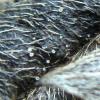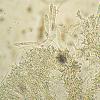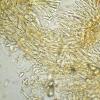
21-12-2025 09:32
Hello.A tiny ascomycete found embedded in wood in

21-12-2025 21:32
Pol DebaenstHello, Garden, Burgweg 19, Veurne, BelgiumOn 10/1

22-12-2025 23:38
Patrice TANCHAUDBonsoir, récolte sur un mur en pierre, apothéci

22-12-2025 00:47
Patrice TANCHAUDBonsoir, récolte à proximité du milieu dunaire

21-12-2025 21:40
Isabelle CharissouBonjour, j'aimerais connaitre les références de

20-12-2025 23:08
Patrice TANCHAUDBonsoir, récolte sur sol sablonneux dans l'arri�

20-12-2025 15:47
Mirek GrycHi.These grew on pine wood that was heavily covere
On Potentilla palustris
Marja Pennanen,
12-07-2010 00:02
I went to find more Moellerodiscus on Potentilla and luckily found some.
But I found something else too. Hymenoscyohus kermesinus and these tiny whitish ascomycetes, which are about 0,1 mm wide (photo is poor):
Marja Pennanen,
12-07-2010 00:04
Hans-Otto Baral,
12-07-2010 08:40

Re:On Potentilla palustris
Hi Marja
I fear this needs more characters. IKI- is a striking feature. But are there any hairs? how is the excipulum? Mollisina would be a possibility. In my database I have only Hyaloscypha secalina for Potentilla with such a spore size that could fit.
H. kermesinus I never identified. How can you be sure? Arendholz had it on Betula leaves.
Zotto
I fear this needs more characters. IKI- is a striking feature. But are there any hairs? how is the excipulum? Mollisina would be a possibility. In my database I have only Hyaloscypha secalina for Potentilla with such a spore size that could fit.
H. kermesinus I never identified. How can you be sure? Arendholz had it on Betula leaves.
Zotto
Marja Pennanen,
12-07-2010 09:38
Re:On Potentilla palustris
Hello Zotto,
this seems not to carry hairs. Photos of bigger magnification were poor, but heres one with smaller magnification.
Hymenoscyphus kermesinus is easy to be identified. It's orange-reddish, short stipate, grows on leaves and has only two spores is asci. I've found it before on betula and salix leaves 5-6 times during two years. So my opinion is, that it is not very rare. I'm quite sure, that I identify it, because last year Seppo confirmed the determination. Before I started to find it on a regular basic, it was found maybe only once in Finland, which is very suprising.
this seems not to carry hairs. Photos of bigger magnification were poor, but heres one with smaller magnification.
Hymenoscyphus kermesinus is easy to be identified. It's orange-reddish, short stipate, grows on leaves and has only two spores is asci. I've found it before on betula and salix leaves 5-6 times during two years. So my opinion is, that it is not very rare. I'm quite sure, that I identify it, because last year Seppo confirmed the determination. Before I started to find it on a regular basic, it was found maybe only once in Finland, which is very suprising.
Marja Pennanen,
12-07-2010 09:43
Marja Pennanen,
12-07-2010 09:49
Hans-Otto Baral,
12-07-2010 10:06

Re:On Potentilla palustris
Strange, this kermesinus! Did you ever test, is it IKI+?
For the minute white I think I can see the Mollisina hairs. narrow, somewhat branched glassy processes. I have one collection of Mollisina with asci IKI-, and this was on Alnus leaves (Mollisina ´alni´, HB 2937.JPG)
Zotto
For the minute white I think I can see the Mollisina hairs. narrow, somewhat branched glassy processes. I have one collection of Mollisina with asci IKI-, and this was on Alnus leaves (Mollisina ´alni´, HB 2937.JPG)
Zotto
Marja Pennanen,
12-07-2010 10:25
Re:On Potentilla palustris
Thank you,
And I saw no hairs ;)
H. kerrmesinus is IKI+ even on my notes. I've got some home, if you want a specimen.
It's not the most typical Hymenoscyphus, but the colouring was Hymenoscyphus like.
Marja
And I saw no hairs ;)
H. kerrmesinus is IKI+ even on my notes. I've got some home, if you want a specimen.
It's not the most typical Hymenoscyphus, but the colouring was Hymenoscyphus like.
Marja
Hans-Otto Baral,
12-07-2010 10:41

Re:On Potentilla palustris
I mainly wonder about whether it could be sclerotiniaceous. Don't send me, I have little time presently. But you could try a photo of the asci in IKI to see if my suspicion is out of question.
Zotto
Zotto
Marja Pennanen,
12-07-2010 11:59
Hans-Otto Baral,
12-07-2010 12:03

Re:On Potentilla palustris
yes I know. At least it does not look like typical Sclerotinia-type. But Moellerodiscus is a possibility. The excipulum is of globose or prismatic cells? Sorry for bothering you...
Zotto
Zotto
Marja Pennanen,
12-07-2010 12:40
Re:On Potentilla palustris
Hello,
don't worry, I should have time. (Just that overcollecting means no time ;) )
I threw the preparate in water after taking too few photos.
Does this help any? If not I'll make another, but I think, that the cells were not globose.
Somehow this story went out of the original line, but that happens...
don't worry, I should have time. (Just that overcollecting means no time ;) )
I threw the preparate in water after taking too few photos.
Does this help any? If not I'll make another, but I think, that the cells were not globose.
Somehow this story went out of the original line, but that happens...
Hans-Otto Baral,
12-07-2010 13:39

Re:On Potentilla palustris
Sorry, there is nothing to see. How big is your fungus? more than 1 mm? Dennis 1956 describes it as 0.5 mm, almost sessile (liek a Calycellina!). Excipulum of isodiametrical cells.
This specis would really need thorough documentation in the living state... I fear there is high confusion.
Zotto
This specis would really need thorough documentation in the living state... I fear there is high confusion.
Zotto
Marja Pennanen,
12-07-2010 15:46
Re:On Potentilla palustris
Well,
I may have mixed these, it belongs to my habits ;) I can't study the types.
Those I found on Potentilla were small (0,3 mm) and almoust sessile.
Those on Betula are larger, maybe 1 mm and short stipate depending of light or something.
Those on Salix are usually larger even 3-4 mm wide and usually short stipate.
But they all have only two spores in asci, are redish and grow on leaves...
I though the size was a matter of metabolism or weather or light or who knows, what they need to grow up ;)
The description is propably taken of a dried sample and I've noticed that I can't always trust the descriptions because of that, sizes and even colours seems to be something about...
I made a preparate of the small, fresh Pontentilla specimen and of a big, dried Salix specimen.
The spores were a little and cells lot bigger in the Salix specimen, but I suppose they can still be the same species. Here's a photo of the salix specimen.
Can it be, that the better (more to digest) substrate make bigger fungi?
I may have mixed these, it belongs to my habits ;) I can't study the types.
Those I found on Potentilla were small (0,3 mm) and almoust sessile.
Those on Betula are larger, maybe 1 mm and short stipate depending of light or something.
Those on Salix are usually larger even 3-4 mm wide and usually short stipate.
But they all have only two spores in asci, are redish and grow on leaves...
I though the size was a matter of metabolism or weather or light or who knows, what they need to grow up ;)
The description is propably taken of a dried sample and I've noticed that I can't always trust the descriptions because of that, sizes and even colours seems to be something about...
I made a preparate of the small, fresh Pontentilla specimen and of a big, dried Salix specimen.
The spores were a little and cells lot bigger in the Salix specimen, but I suppose they can still be the same species. Here's a photo of the salix specimen.
Can it be, that the better (more to digest) substrate make bigger fungi?
Hans-Otto Baral,
12-07-2010 17:50

Re:On Potentilla palustris
Such big differences in apo size are strange. I think Dennis rehydrated the apothecia for describing, but I am, not sure.
A macrophoto of the small ones on Potentlla would be nice, to get an idea. The micros you added are from Potentilla or Salix?
Zotto
A macrophoto of the small ones on Potentlla would be nice, to get an idea. The micros you added are from Potentilla or Salix?
Zotto
Marja Pennanen,
12-07-2010 18:01
Re:On Potentilla palustris
Heres a photo of these on potentilla.The biggest one was about 0,5 mm.
The first micro is on potentilla the middle ones on Betula and the last as I mentioned on Salix.
I started to reall some síze differences I've noticed and Scutellinia scutellata came to my mind.
I've sometimes found quite small on sand (maybe there was a tree root down, don't know), they were much smaller than those I meet on stumps or plant debris.
And what about Hymenoscyphus scutula on grasses and other substrates...
The first micro is on potentilla the middle ones on Betula and the last as I mentioned on Salix.
I started to reall some síze differences I've noticed and Scutellinia scutellata came to my mind.
I've sometimes found quite small on sand (maybe there was a tree root down, don't know), they were much smaller than those I meet on stumps or plant debris.
And what about Hymenoscyphus scutula on grasses and other substrates...
Hans-Otto Baral,
13-07-2010 11:04

Re:On Potentilla palustris
These differences in apo size do exist, actually. In Sarcoscypha they can easily be explained by the volume of the available substrate. In other cases it is not that clear. Variability is everywhere, and often the constantand important characters are small and hidden, or only seen in mature living specimens.
Zotto
Zotto









